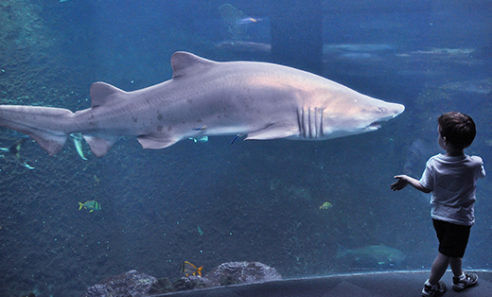Journey in the High Seas is a new exhibition housed inside an all new extension building at Nausicaá making it now the largest aquarium in Europe and perhaps the fourth or fifth largest aquarium in the world
Already well established as a major tourist attraction close by the channel crossing points in Calais, Nausicaà in Boulogne sur Mer has unveiled Journey in the High Seas” exhibitionthe next stage in its bold expansion programme.
The new extension, which opened in May this year, centres around a huge 10,000 cubic metre tank which recreates the underwater ecosystem of the High Seas.
Management of the high seas is one of the major challenges of the 21st century, and the issue of governance is being discussed by the United Nations.
Walking around the new exhibition, visitors get a real sense of the vastness of a powerful and living ocean.
The underwater landscaping is modelled on the island of Malpelo off the coast of Colombia.
The island of Malpelo is a huge marine sanctuary inhabited by many endangered species. On the ground, the Malpelo Foundation is exploring the reason why some of their numbers have declined, including hammerhead sharks, which are suffering from overfishing.
Nausicaá supports the work of the Malpelo Foundation, and in particular a research project in the Malpelo sanctuary which focuses on the conservation of hammerhead sharks, a key species in the “Journey in the High Seas” underwater exhibition.
Acoustic tags are attached to sharks in order to track individuals with the aid of receivers placed on the sea floor.
Nausicaá has put a receiver in the big tank so that visitors can see what it looks like.
In the spring of 2018, the Malpelo Foundation had already tagged five female hammerhead sharks.
Nausicaá is providing financial support to the Foundation and will share the results of the various expeditions with its visitors and on its website. It will be possible to tag many more sharks thanks to the support from Nausicaá.
Malpelo, an island on the open sea – a unique place in the world
The island of Malpelo, which is located in the Pacific at a distance of over 500 km from the coast of Colombia, is the protruding part of a unique undersea mountain range of volcanic origin called the Malpelo Ridge. This big rock with an area of 1.2 km2, rises to a height of 300 metres andoverlooks an ocean floor which lies at a depth of 4,000 metres down below!
Its geographical location at the crossroads of several powerful sea currents and its geological structure make Malpelo a unique place with a wide range of different natural environments: coral habitats close to the surface, vertical habitats in the caves and tunnels that go deep into the rock to the very depths, and pelagic habitats around the island and the neighbouring rocks.
So Malpelo is an extraordinary refuge for species that do not live together anywhere else!
The Malpelo Foundation
Created in 1999 by the French-Colombian biologist and diver Sandra Bessudo, the Malpelo Foundation works to protect the island and combat illegal fishing and shark fin fishing.
The Foundation is conducting a shark tagging campaign involving acoustic telemetry which has established a link between the different islands of the tropical eastern Pacific. This work is being done within a network called MIGRAMAR which has been set up with other organisations
The scientists have found that the populations of all of the species have been recovering over the past few years with the exception of hammerhead sharks, which are suffering from overfishing. These sharks go down to a depth of 1,000 metres and yo-yo their way back up to between 100 metres and the surface. When a group moves upwards, it is decimated by fishermen even though direct fishing of sharks is banned.
Classifying the species as endangered, stepping up monitoring and legislating for tougher penalties are steps that have been taken to combat this illegal fishing.
Malpelo – World Heritage
Due to its isolation and the desert-like nature of the rock, on which there is no fresh water, Malpelo has been protected from human activities. In 1995, the island became a Fauna and Flora Sanctuary and joined Colombia’s network of national parks. In 2002, the International Maritime Organisation (IMO) declared the sanctuary a “Particularly Sensitive Sea Area” and banned the intense commercial shipping towards the Panama Canal area from entering it. In 2006, the Marine Protected Area was expanded to a total area of 857,465 hectares.
Fishing is banned in this area, where the Colombian navy carries out surveillance patrols. In 2006, Malpelo was declared a natural World Heritage Site by UNESCO. In 2017, the Marine Protected Area was expanded again (from 9,585 km2 to 27,096 km2) and became a bi-national park which is shared with Panama.


